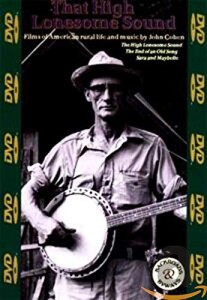 John Cohen is perhaps better known as a member of the New Lost City Ramblers. This group of city boys playing the old time music of America influenced almost every musician interested in traditional American music who came along. Bob Dylan, Jerry Garcia, Taj Mahal, Ry Cooder, and on and on, all list the Ramblers as influences. But for forty years now, John Cohen has also been a photographer and film-maker. His photographs of musicians were recently celebrated by the twin release of a book and CD entitled There Is No Eye. Now this DVD combines three early Cohen films, each concerned (as the subtitle tells us) as much with the life as with the music of rural America.
John Cohen is perhaps better known as a member of the New Lost City Ramblers. This group of city boys playing the old time music of America influenced almost every musician interested in traditional American music who came along. Bob Dylan, Jerry Garcia, Taj Mahal, Ry Cooder, and on and on, all list the Ramblers as influences. But for forty years now, John Cohen has also been a photographer and film-maker. His photographs of musicians were recently celebrated by the twin release of a book and CD entitled There Is No Eye. Now this DVD combines three early Cohen films, each concerned (as the subtitle tells us) as much with the life as with the music of rural America.
Cohen’s website claims that “although it has the appearance of a ‘documentary style’ [his work] reflects his own viewpoint as a visual artist.” This was the first thing I noticed. As I sat in front of the television on a rainy Saturday morning I was seeing images of Kentucky coalmines; miners black-faced but smiling, waving at the camera; their wives shopping at the company store; the preacher proclaiming the truth; the children playing on the dirt road; and a skinny man in a big hat playing the banjo on his front porch while a neighbor buckdanced next to him. Shot on one handheld camera, this footage was filmed with no sound. Perhaps an assistant was behind Cohen, operating a cumbersome reel to reel tape recorder … perhaps not. But the audio was added later, that much is obvious. Doesn’t matter though. The feel of the audio is every bit as spontaneous, yet carefully selected as the images. Roscoe Holcomb. That’s the man playing the banjo. That’s the “high, lonesome sound” the title mentions, coming out of his mouth, and from his fretboard. Eric Clapton once told an interviewer that this Roscoe Holcomb was his “favorite country musician.” Hmmm.
The coal miners, their families, the farmers, trying to eke a living out of a little bit of ground, and music. Always music. It’s a part of their life, not something tagged on, or plugged in by radio or MTV! Whether represented by Holcomb’s guitar or banjo, or by the group singing at the church (inside the building or at the riverside baptism), or even at an outside concert by Bill Monroe and His Bluegrass Boys, music exists within the reality of their existence. This is something that we miss. Last week I was at a business meeting. We went for dinner one night at the home of an associate, just 20 people gathered for dinner, and drinks. I brought my guitar, and my friend (actually he’s my boss too) Bart brought two cases of harmonicas. After supper, we broke out the instruments and this group of fairly conservative managers and directors sang along and danced to acoustic music. It was wonderful…this is the reality of Hazard, Kentucky! Cohen captures it brilliantly, even if he had to cut and paste it to present it. His “vision” should be reality.
The second film is called “The End of an Old Song.” In this film Cohen paints a protrait of Dillard Chandler, unaccompanied ballad singer. We discover that he has no family, money or friends, but music is the essence of his life. Shakespeare said that “music hath charms that sooth the savage breast,” but even more than that. A Greek philosopher once wrote that “when the mode of music changes the city walls will crumble.” This is the power of music, and Dillard Chandler understood that, even when his songs were being drowned out by the loud jukebox music of encroaching technology. John Cohen understands that too, and has worked his whole life, in various media, to tell others.
The program ends with Cohen’s portrait of Sara and Maybelle, two of the original Carter Family. Maybelle’s daughter June Carter Cash, who passed on a week ago, was part of this legendary clan. This film shows the sisters playing Carter Family classics. We see interviews where Sara talks about the legendary session in Bristol, Tennessee, that launched their career and laid the foundation for country music. Cohen’s ad hoc camerawork adds spontaneity and intimacy to his films and makes the transition from contemporary fast cut video to the slower movement in these older films easier for today’s viewer.
These three films are best watched one at a time. Soaked up, revelled in. Not necessarily easy viewing, they are nonetheless essential for an understanding of our past, and an appreciation of the impact music can, and should, have on our lives.
(Shanachie Entertainment DVD, 2002)
